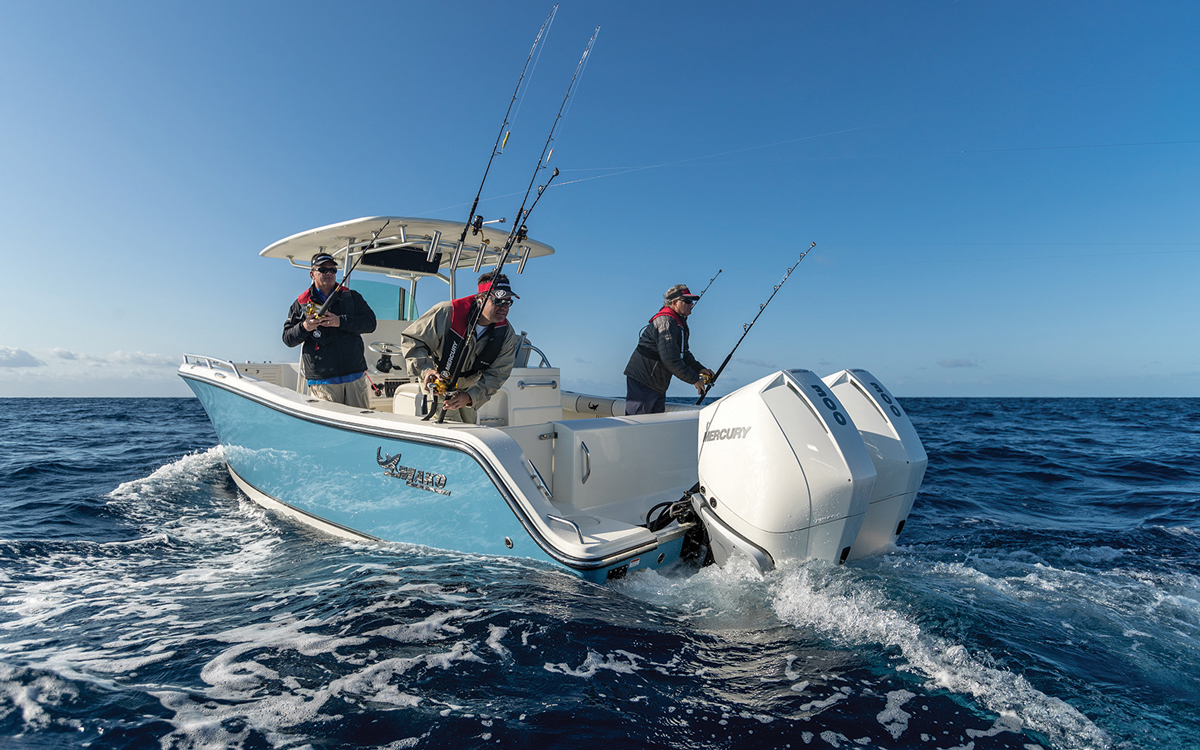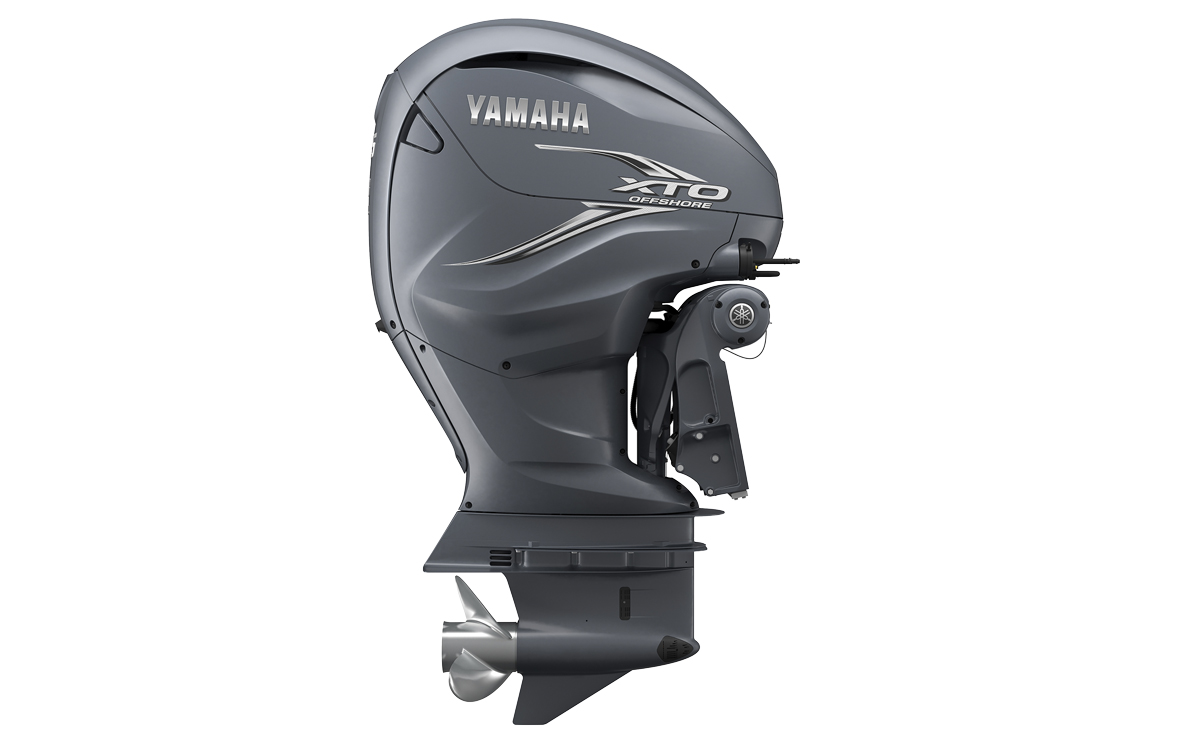With the rise and rise of big capacity motors set to continue, we pit the Mercury Verado against the Yamaha XTO in a head-to-head V8 outboard comparison
The inexorable rise of big outboard engines has taken another step forward with the launch of two powerful new V8s. Mercury didn’t wait long after taking the wraps off a new family of 175-225hp V6 outboard engines before introducing an even more powerful range of 250-300hp V8 outboards.
As if that weren’t enough, Yamaha has also launched a whopping 425hp V8 XTO. So what differentiates these two new contenders, and why the sudden explosion in big-capacity V8 outboards?
Mercury Verado V8 outboard
In truth, the new V8 Verado is no great surprise. Having gone to the trouble of designing a brand new naturally aspirated V6, it makes sense to tack on a couple of extra cylinders and create a new V8 outboard as well. Not surprisingly, each cylinder shares the same bore and stroke as the new V6, taking the total capacity up from 3.4 litres to 4.6 litres.

Mercury’s new 300hp Verados use naturally aspirated V8s rather than the previous engine’s supercharged 6-cylinder blocks
This makes it not only the largest-capacity 300hp engine on the market (the next biggest is Yamaha’s 4.2-litre F300) but also the only one to use a V8 configuration. According to Mercury, this gives it a crucial advantage in terms of both performance and refinement.
Although it’s best to take performance figures supplied by the manufacturer with a pinch of salt, Mercury claims that in a back-to-back test with a ‘leading 300hp competitor’, the new 300hp Verado was 20% quicker from 0-20mph and 2mph faster flat out.
Neither manufacturer has released precise torque figures but again, Mercury claims that between 3,500 and 4,500rpm, its V8 outboard has a 12-15% advantage. It puts much of this down to its new Transient Spark technology, which is said to boost torque by up to 7% during the critical hole shot test.
Article continues below…

Diesel outboard head-to-head test: Cox CXO 300hp vs Oxe 200hp

Yamaha 425hp outboard: Most powerful V8 set-up tested
Like the new V6, the naturally aspirated V8 outboard has a number of distinct advantages over the supercharged Verados it replaces. Foremost among these is fuel economy. Superchargers are notoriously thirsty as they absorb a considerable amount of power just to drive them. They also add weight, bulk, noise and friction.
While Mercury has avoided any comparisons with its own supercharged predecessor, it does claim that the new 300hp V8 is 8% more economical than its leading competitor. However, perhaps the most arresting claim is that the new engine is 20% quieter at idle, and 35% quieter at cruise and wide-open throttle than the leading 4-stroke competitor, with 65% less vibration at the helm.
Other features include a pop-up flap in the cowling to check the oil level, and adaptive speed control, which holds the engine speed at your chosen RPM regardless of changes in load or conditions, such as when towing a waterskier or ploughing through lumpy seas.
The one area where it doesn’t compare so well with its 300hp rivals is weight. The lightest 20in shaft model tips the scales at 272kg – 18kg heavier than Yamaha’s F300. Given that it boasts a bigger block with two extra cylinders and all the associated valve gear, Mercury has done well to keep the weight as low as it has.
The bigger question is where the new V8 leaves the 350hp and 400hp Verados with their 6-cylinder supercharged blocks, particularly in light of Yamaha’s thumping new 425hp naturally aspirated V8 outboard. Surely it’s only a matter of time before these flagship Verados get a rethink too?
Yamaha XTO Offshore V8 outboard
Yamaha was the first manufacturer to offer a V8 outboard when it launched the F350 back in 2007. At the time, it was the most powerful outboard available, even if its sheer size and weight meant that it was better suited to large American sportsfishers than lighter, faster sportsboats and RIBs. Its real selling point was the massive torque of its big-capacity 5.3-litre block.
The new XTO Offshore picks up where the F350 leaves off, delivering an unparalleled 425hp at 5,500rpm from its all-new 5.6-litre V8 block. As ever, Yamaha hasn’t revealed a peak torque figure but does describe it as ‘delivering the sheer brute force to push the heaviest and largest offshore boats and luxury RIBs’.
Generating that much power reliably and converting it into useable thrust takes some doing, and Yamaha has pulled out all the stops to achieve it. It is the first 4-stroke outboard engine to use direct injection technology. No fewer than five fuel pumps pressurise the petrol to 2,900 PSI before injecting it directly into the combustion chamber in a finely atomised spray.
Coupled with a high compression ratio of 12.2:1, it makes for a faster, cleaner more complete burn. In addition, the sleeveless cylinder liners are plasma fused to create a micro-textured surface that is 60% harder than steel, which in turn allows for thinner cylinder walls and a lighter, more compact engine block.
The twin overhead camshafts are driven by a self-tensioning chain immersed in an oil bath for durability, while carbon-coated valve lifters promote longevity and precision timing. An oversized gearcase with hardened gears swings a single high-thrust propeller designed to make the most of the engine’s high torque output. A two-stage exhaust that vents through the leg at low rpm but through the prop hub at faster speeds also allows faster reversing speeds for big-game fishing.
Of more relevance to European buyers is the all-electric steering system that is safely tucked inside the engine cowling and removes the need for hydraulic cables running to and from the helm. Last but not least, the cowling comes apart in sections to ease removal while the gear oil can be changed without lifting the boat out of the water.
It all adds up to a package that Yamaha says is the toughest, most reliable, most convenient, most advanced outboard engine yet produced, a claim it is happy to back up with a comprehensive five-year warranty. At 442kg, it’s still better suited to larger craft than Mercury’s lighter (303kg) Verado 400R, but if size is your thing, the Yamaha XTO V8 outboard is the new king of the waves.
Head-to-head comparison
| Model | Mercury V8 Verado |
Yamaha V8 XTO Offshore |
|---|---|---|
| Capacity | 4.6-litre | 5.6-litre |
| Power | 300hp | 425hp |
| Max revs | 6,000rpm | 5,500rpm |
| Weight | 272kg | 442kg |
First published in the August 2018 edition of Motor Boat & Yachting.











